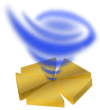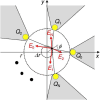Nano-shaping of chiral photons
- PMID: 39633766
- PMCID: PMC11502058
- DOI: 10.1515/nanoph-2022-0779
Nano-shaping of chiral photons
Abstract
Localized surface plasmon polaritons can confine the optical field to a single-nanometer-scale area, strongly enhancing the interaction between photons and molecules. Theoretically, the ultimate enhancement might be achieved by reducing the "photon size" to the molecular extinction cross-section. In addition, desired control of electronic transitions in molecules can be realized if the "photon shape" can be manipulated on a single-nanometer scale. By matching the photon shape with that of the molecular electron wavefunction, optically forbidden transitions can be induced efficiently and selectively, enabling various unconventional photoreactions. Here, we demonstrate the possibility of forming single-nanometer-scale, highly intense fields of optical vortices using designed plasmonic nanostructures. The orbital and spin angular momenta provided by a Laguerre-Gaussian beam are selectively transferred to the localized plasmons of a metal multimer structure and then confined into a nanogap. This plasmonic nano-vortex field is expected to fit the molecular electron orbital shape and spin with the corresponding angular momenta.
Keywords: Laguerre–Gaussian mode; localized surface plasmon; nano-vortex; optically forbidden electronic transition; plasmonic nanoantenna.
© 2023 the author(s), published by De Gruyter, Berlin/Boston.
Figures




Similar articles
-
Beaming of Helical Light from Plasmonic Vortices via Adiabatically Tapered Nanotip.Nano Lett. 2016 Oct 12;16(10):6636-6643. doi: 10.1021/acs.nanolett.6b03359. Epub 2016 Sep 14. Nano Lett. 2016. PMID: 27618524 Free PMC article.
-
Deuterogenic Plasmonic Vortices.Nano Lett. 2020 Sep 9;20(9):6774-6779. doi: 10.1021/acs.nanolett.0c02699. Epub 2020 Aug 25. Nano Lett. 2020. PMID: 32804512
-
Plasmonic topological quasiparticle on the nanometre and femtosecond scales.Nature. 2020 Dec;588(7839):616-619. doi: 10.1038/s41586-020-3030-1. Epub 2020 Dec 23. Nature. 2020. PMID: 33361792
-
Optical Processes behind Plasmonic Applications.Nanomaterials (Basel). 2023 Apr 3;13(7):1270. doi: 10.3390/nano13071270. Nanomaterials (Basel). 2023. PMID: 37049363 Free PMC article. Review.
-
Plasmons in nanoscale and atomic-scale systems.Sci Technol Adv Mater. 2011 Jan 10;11(5):054506. doi: 10.1088/1468-6996/11/5/054506. eCollection 2010 Oct. Sci Technol Adv Mater. 2011. PMID: 27877363 Free PMC article. Review.
Cited by
-
Special issue: Metamaterials and plasmonics in Asia, a tribute to Byoungho Lee.Nanophotonics. 2023 Jun 22;12(13):2241-2243. doi: 10.1515/nanoph-2023-0343. eCollection 2023 Jun. Nanophotonics. 2023. PMID: 39633773 Free PMC article. No abstract available.
References
-
- Friese M. E., Nieminen T. A., Heckenberg N. R., Rubinsztein-Dunlop H. Optical alignment and spinning of laser-trapped microscopic particles. Nature. 1998;394(6691):348–350. doi: 10.1038/28566. - DOI
-
- Watson M. L., Brown D. L., Stilgoe A. B., Stow J. L., Rubinsztein-Dunlop H. Rotational optical tweezers for active microrheometry within living cells. Optica. 2022;9(9):1066–1072. doi: 10.1364/optica.468713. - DOI
LinkOut - more resources
Full Text Sources
